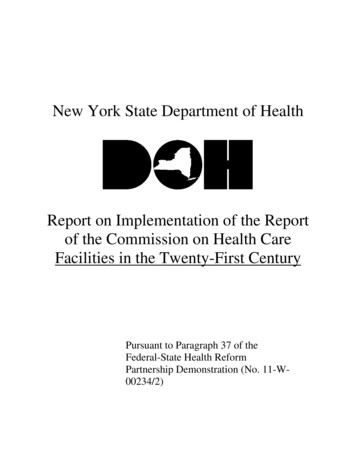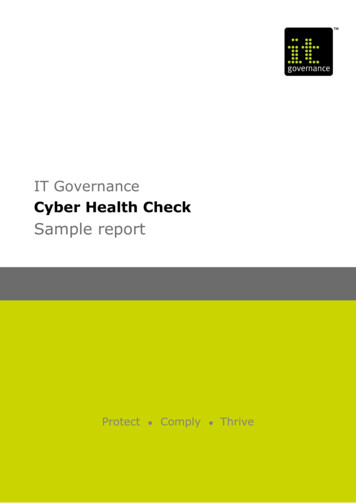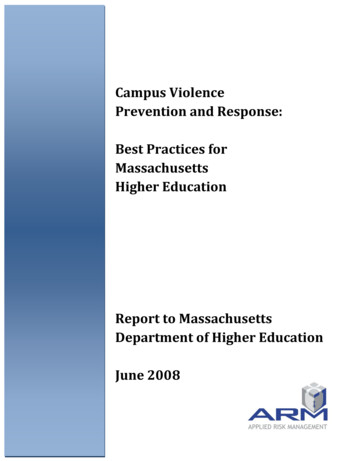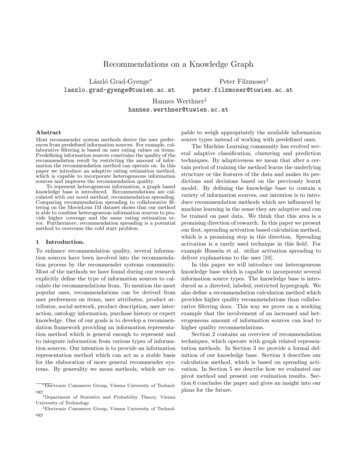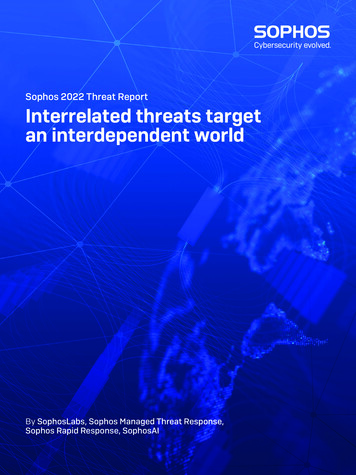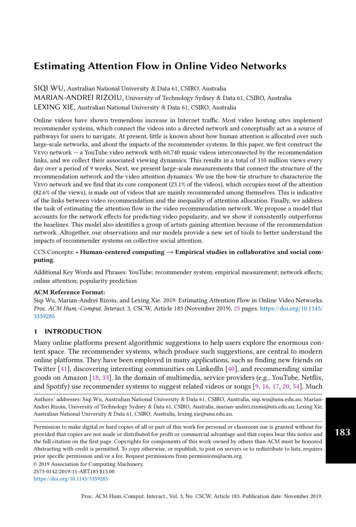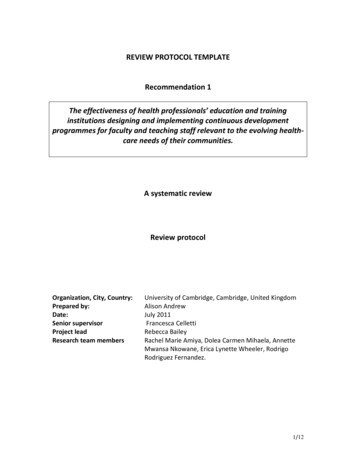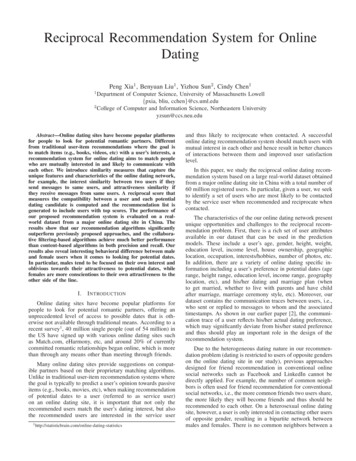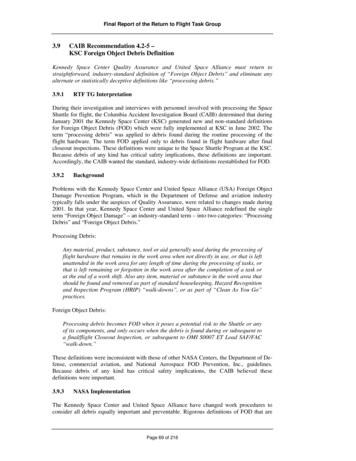
Transcription
Final Report of the Return to Flight Task Group3.9CAIB Recommendation 4.2-5 –KSC Foreign Object Debris DefinitionKennedy Space Center Quality Assurance and United Space Alliance must return tostraightforward, industry-standard definition of “Foreign Object Debris” and eliminate anyalternate or statistically deceptive definitions like “processing debris.”3.9.1RTF TG InterpretationDuring their investigation and interviews with personnel involved with processing the SpaceShuttle for flight, the Columbia Accident Investigation Board (CAIB) determined that duringJanuary 2001 the Kennedy Space Center (KSC) generated new and non-standard definitionsfor Foreign Object Debris (FOD) which were fully implemented at KSC in June 2002. Theterm “processing debris” was applied to debris found during the routine processing of theflight hardware. The term FOD applied only to debris found in flight hardware after finalcloseout inspections. These definitions were unique to the Space Shuttle Program at the KSC.Because debris of any kind has critical safety implications, these definitions are important.Accordingly, the CAIB wanted the standard, industry-wide definitions reestablished for FOD.3.9.2BackgroundProblems with the Kennedy Space Center and United Space Alliance (USA) Foreign ObjectDamage Prevention Program, which in the Department of Defense and aviation industrytypically falls under the auspices of Quality Assurance, were related to changes made during2001. In that year, Kennedy Space Center and United Space Alliance redefined the singleterm “Foreign Object Damage” – an industry-standard term – into two categories: “ProcessingDebris” and “Foreign Object Debris.”Processing Debris:Any material, product, substance, tool or aid generally used during the processing offlight hardware that remains in the work area when not directly in use, or that is leftunattended in the work area for any length of time during the processing of tasks, orthat is left remaining or forgotten in the work area after the completion of a task orat the end of a work shift. Also any item, material or substance in the work area thatshould be found and removed as part of standard housekeeping, Hazard Recognitionand Inspection Program (HRIP) “walk-downs”, or as part of “Clean As You Go”practices.Foreign Object Debris:Processing debris becomes FOD when it poses a potential risk to the Shuttle or anyof its components, and only occurs when the debris is found during or subsequent toa final/flight Closeout Inspection, or subsequent to OMI S0007 ET Load SAF/FAC“walk-down.”These definitions were inconsistent with those of other NASA Centers, the Department of De fense, commercial aviation, and National Aerospace FOD Prevention, Inc., guidelines.Because debris of any kind has critical safety implications, the CAIB believed thesedefinitions were important.3.9.3NASA ImplementationThe Kennedy Space Center and United Space Alliance have changed work procedures toconsider all debris equally important and preventable. Rigorous definitions of FOD that arePage 69 of 216
Final Report of the Return to Flight Task Groupthe industry standard have been adopted. These new definitions adopted from NationalAerospace FOD Prevention, Inc. guidelines and industry standards include Foreign ObjectDebris, Foreign Object Damage, and Clean-As-You-Go. FOD is redefined as “a substance,debris or article alien to a vehicle or system which would potentially cause damage.”The new FOD program is anchored in three fundamental areas of emphasis. First, iteliminates various categories of FOD, including “processing debris,” and treats all FOD aspreventable and with equal importance. Second, it reemphasizes the responsibility andauthority for FOD prevention at the operations level. FOD prevention and elimination arestressed and the work force is encouraged to report any and all FOD found by entering thedata in the FOD database. This activity is performed with the knowledge that finding andreporting FOD is the goal of the Program and employees will not be penalized for theirfindings. Third, it elevates the importance of comprehensive independent monitoring by bothcontractors and the Government.United Space Alliance has also developed and implemented new work practices andstrengthened existing practices. This new rigor will reduce the possibility for temporaryworksite items or debris to migrate to an out-of-sight or inaccessible area, and it servesan important psychological purpose ineliminating visible breaches in FODprevention discipline.The new FOD program has a meaningful setof metrics to measure effectiveness and toguide improvements. FOD walkdownfindings will be tracked in the IntegratedQuality Support Database. This databasewill also track FOD found during closeouts,launch countdowns, post-launch padturnarounds, landing operations, and NASAquality assurance audits. “Stumble-on”FOD findings will also be tracked, as theyoffer an important metric of programeffectiveness independent of planned FODprogram activities. For all metrics, the types of FOD and their locations will be recorded andanalyzed for trends to identify particular areas for improvement. Monthly metrics reporting tomanagement will highlight the top five FOD types, locations, and observed workforcebehaviors, along with the prior months’ trends. Continual improvement will be a hallmark ofthe revitalized FOD program.The implementation of the new program began on July 1, 2004, although many aspects of theplan existed in the previous FOD prevention program in place at KSC. Assessment audits byNASA and United Space Alliance were conducted beginning in October 2004. CorrectiveAction Plans have been established to address the findings and observations identified duringthe two audits. Schedules for the verification of the actions taken and for verifying theeffectiveness of the corrective actions have been established to ensure the ongoingeffectiveness of the FOD prevention program. Continual improvement will be vigorouslypursued for the remainder of the life of the Space Shuttle.3.9.4RTF TG AssessmentThe FOD Program at the Kennedy Space Center was very effective in the past. When thedefinitions were modified during 2001 to create multiple categories of debris, the workforcewas not sufficiently trained to understand the implications. This confusion was expressed tothe CAIB members during their interviews with KSC personnel; in response to the CAIBrecommendation, KSC reevaluated the entire program. The Task Group concluded fact-Page 70 of 216
Final Report of the Return to Flight Task Groupfinding during a technical interchange meeting at KSC in May 2004. This complementedprevious meetings with KSC quality assurance and United Space Alliance personnel in late2003 and early 2004.The Kennedy Space Center and United Space Alliance have changed the definition of“Foreign Object Debris” to be consistent with the recognized and accepted industry standard.Further, they have removed the misleading category of processing debris that caused concern.They have improved the training of the workforce, and obtained buy-in at all levels for bothNASA and all contractors. The revised program has implemented several improvementsabove and beyond the expectations defined in the CAIB recommendation. The FOD databasehas been made significantly more robust and captures a higher level of reporting detail thanexisted previously. NASA management has demonstrated their buy-in with participation in“walk-downs” to inspect for FOD.The RTF TG initial assessment of NASA’s actions was completed at the July 22, 2004,teleconference plenary where the assessment was conditionally closed. After receiving auditresults and specified corrective actions from NASA, the assessment was closed at theDecember 16, 2004, meeting. The intent of CAIB Recommendation 4.2-5 has been met.3.9.5RTF TG ObservationIt is very important for NASA management to provide positive incentives for the reporting ofFOD and to avoid negative sanctions for those who self-report. The Task Group believesmanagement is sufficiently sensitive to this need and will provide the proper positive andnegative feedback to the workforce. Metrics defined and tracked by NASA will assurecontinued compliance with the new improved FOD program.Discovery duringearly processing forSTS-114. Thereinforced carboncarbon nosecap hadbeen removed andreturned to thevendor for testing.Note the open noselanding gear door atthe bottom left.Page 71 of 216
Final Report of the Return to Flight Task GroupThe CrawlerTransporter drivesaway after deliveringDiscovery on herMobile LaunchPlatform to LaunchComplex 39B.Page 72 of 216
Final Report of the Return to Flight Task Group3.10 CAIB Recommendation 6.2-1 –Consistency with ResourcesAdopt and maintain a Shuttle flight schedule that is consistent with available resources.Although schedule deadlines are an important management tool, those deadlines must beregularly evaluated to ensure that any additional risk incurred to meet the schedule isrecognized, understood, and acceptable.3.10.1RTF TG InterpretationThe Columbia Accident Investigation Board (CAIB) explicitly recognized the legitimate useof schedules to drive a process. They were concerned, however, that the line between“beneficial” schedule pressures and those that become detrimental, cannot be easily defined ormeasured. In the case of Columbia, the CAIB discovered that pressure on the Space ShuttleProgram was created by the schedule for construction of the International Space Station.Indeed, the planned February 2004 completion of Node 2 of the International Space Stationwas being touted as a measure of NASA’s ability to maintain a schedule.The CAIB further observed that budget constraints inherently intensify the conflicts betweenschedule and safety. The meaning of the first sentence of the CAIB recommendation is clear:adjust the schedule to fit the available resources.3.10.2BackgroundDuring the course of the Columbia investigation, the CAIB received several unsolicitedcomments from NASA personnel regarding pressure. Oddly, the pressure was to meet a datemore than a year after the launch of STS-107 that seemed etched in stone: February 19, 2004,the scheduled launch of STS-120. This flight was a milestone in the minds of NASAmanagement since it would carry a section of the International Space Station called “Node 2”that would signal “U.S. Core Complete.”At first glance, the U.S. Core Complete date seemed noteworthy but unrelated to theColumbia accident. However, as the investigation continued, it became apparent to theaccident board that the political mandates surrounding the International Space StationProgram, as well as the Space Shuttle Program management’s responses to them, resulted inpressure to meet an increasingly ambitious launch schedule.Meeting U.S. Core Complete by February 19, 2004 – a date the CAIB found was promised byNASA management to the White House and Congress – would require launching 10 SpaceShuttle missions in less than 16 months. With the focus on retaining political support for theInternational Space Station Program, little attention was paid to the effects the aggressiveNode 2 launch date would have on the Space Shuttle Program. After years of downsizing andbudget cuts, this mandate introduced elements of risk, and the high-pressure environmentscreated by NASA Headquarters unquestionably affected Columbia, even though it was notflying to the International Space Station.After considering what they had uncovered during their investigation, the CAIB concluded:“The agency’s commitment to hold firm to a February 19, 2004, launch date forNode 2 influenced many of decisions in the months leading up to the launch ofSTS-107, and may well have subtly influenced the way managers handled theSTS-112 foam strike and Columbia’s as well.“When a program agrees to spend less money or accelerate a schedule beyond whatthe engineers and program managers think is reasonable, a small amount of overallPage 73 of 216
Final Report of the Return to Flight Task Grouprisk is added. These little pieces of risk add up until managers are no longer aware ofthe total program risk, and are, in fact, gambling. Little by little, NASA wasaccepting more and more risk in order to stay on schedule.”3.10.3NASA ImplementationNASA has strengthened a risk management system that it believes balances technical,schedule, and resource risks to achieve safe and reliable operations. Under this system, safetyis ensured by first focusing on the technical risks and taking the time and financial resourcesnecessary to properly resolve them. Once technical risks are reduced to an acceptable level,program managers turn to the management of schedule and resource risks to preserve safety.Among the activities NASA plans to undertake are more routinely assessing schedule risk,incorporating additional margin into the schedule and manifest to accommodate changes, andrevising databases so schedule and risk indicators can be assessed by managers in real-time.KSC and United Space Alliance management use the Equivalent Flow Model (EFM) to planresources that are consistent with the Space Shuttle flight schedule and available workforceneeded to meet the technical requirements. The EFM is a computerized tool that uses aplanned manifest and past performance to calculate processing resource requirements. Theworkforce, a primary input to the EFM tool, comprises fixed resources, supporting core dailyoperations, and variable resources that fluctuate depending on the manifest. Using pastmission timelines and actual hours worked, an “equivalent flow” is developed to establish therequired processing hours for a processing flow.To assess and manage the manifest, NASA has developed a process called the ManifestAssessment System that incorporates all manifest constraints and influences, and allowsadequate margin to accommodate a normalized amount of changes. This process entailsbuilding in launch margin, cargo and logistics margin, and crew timeline margin whilepreserving the technical element needed for safe and reliable operations. United SpaceAlliance is using the Manifest Assessment System to assess the feasibility of proposedtechnical and manifest changes to determine how changes to facility availability, schedule, orduration of flight production activities affect the overall manifest schedule. This capabilityenables a more useful way to implement realistic, achievable schedules while successfullybalancing technical, schedule, and resource risks to maintain safe and reliable operations.Policies are also in place to ensure the workforce health at KSC in the face of scheduledeadlines. The Maximum Work Time Policy, found in KSC Handbook (KHB) 1710.2, section3.4 includes daily, weekly, monthly, yearly, and consecutive hours worked limitations.Deviations require senior management approval up to the KSC Center Director andindependent of the Space Shuttle Program. KSC work time safeguards ensure that whenavailable resource capacity is approached, the schedule is adjusted to safely accommodate theadded work. When possible, launches are planned on Wednesdays or Thursdays to minimizeweekend hours and associated costs; repeated launch attempts are scheduled to reduce crewand test team fatigue. Overtime hours and safety hazard data are continually monitored byKSC and Space Shuttle Program management for indications of workforce stress.3.10.4RTF TG AssessmentThe CAIB explored a number of root causes for the Columbia accident; one of these was thedesire to maintain a schedule for achieving U.S. Core Complete during construction of theInternational Space Station. The ISS Program had a long history of cost and scheduleoverruns and had been the subject of numerous Congressional hearings and independentcommissions. NASA was determined to complete construction with as few additionalbudgetary resources as possible. In this environment, there was a reluctance to expend theresources to investigate obvious problems with the Space Shuttle, among them the sheddingof foam from the External Tank (ET). Damage to a Solid Rocket Booster – caused by foamPage 74 of 216
Final Report of the Return to Flight Task Groupfrom the ET – two flights before Columbia, prompted a study into the anomaly, but even thiswas not enough to cause anyone to waiver from the schedule.Thus CAIB recommended that NASA “Adopt and maintain a Space Shuttle flight schedulethat is consistent with available resources ” Recognizing the ongoing nature of thisrecommendation, the Task Group believes it will take vigilance in the future to maintain the“appropriate” pressure necessary to maintain a schedule for such a complex system withoutthe pressure becoming, for any reason, “undue.”Recognizing the difficulty in assessing this recommendation, the Task Group undertookseveral activities in an attempt to evaluate the presence of “undue” schedule pressure and thegeneral availability of resources. The Task Group consistently explored the question ofadequacy of resources in virtually every meeting with NASA personnel – from Headquartersstaff to the workforce on the floor of the Kennedy Space Center. The answer has always beenthe same: “ there are sufficient budgetary resources for return to flight.”Recognizing that any assessment is a snapshot, the Task Group also requested data onovertime and other work rule exceptions. The RTF TG looked at reports on sick leave,employee assistance visits, accidents, and near-accidents (close-calls or “diving catches”), aswell as reports of problems with the quality of workmanship being performed. Altogether,these data, compared with previous intervals prior to launch, showed no unusual patternssuggestive of substantial adverse pressure.During the middle of 2004, press reports claimed NASA personnel were concerned aboutresources and the possibility of workforce reductions. The RTF TG was not able to confirmthese reports and notes most were made prior to the finalization of the Fiscal Year 2005NASA budget, during a time when exercises were being conducted to assess the impacts ofvarious alternative levels of spending. NASA was one of the few federal agencies to receivefull funding, although funding for aeronautics programs was severely cut to fund spaceinitiatives, particularly the Vision for Space Exploration.The Task Group also had the opportunity to assess the outcome of NASA’s budget requestsover the last two years. Last year (FY05), Congress actually added funds to the request toaugment return-to-flight activities, and this year has taken actions to help protect resources forNASA in the future. And while NASA has somewhat reduced funding for the HeadquartersOffice of Safety and Mission Assurance, the Task Group has been assured these reductionswill have no effect on return-to-flight activities.The RTF TG assessment of NASA’s actions was completed at the June 8, 2005, meeting. Theintent of CAIB Recommendation 6.2-1 has been met.3.10.5RTF TG ObservationsResource sufficiency is also tied to the scheduled retirement date for the Space Shuttle, andany evaluation of whether to keep Space Shuttle in service past 2010 should include areassessment of actions and upgrades not undertaken, and any long term items already deletedfrom work and acquisition cycles, including the Service Life Extension Program.The Task Group also observes that resource constraints will likely pressure future programs,such as the Vision for Space Exploration. There will always be pressure for under-fundingand overly-aggressive scheduling that must be recognized and mitigated by senior leadership.Along these lines, NASA must address the size and mixture of its future workforce toaccomplish its new missions.As new NASA space flight programs evolve, the Space Shuttle could well be caught betweenPage 75 of 216
Final Report of the Return to Flight Task Groupcompeting goals (e.g., the 2010 retirement date, Hubble SM4, and the delays in fielding a newvehicle). NASA will need to exercise great rigor to ensure that competing budgetaryrequirements do not affect the safety and reliability of Space Shuttle.Discovery at thebeginning of herslow trip to LaunchComplex 39B, asseen from inside theVehicle AssemblyBuilding.Page 76 of 216
Final Report of the Return to Flight Task Group3.11 CAIB Recommendation 6.3-1 –Mission Management Team ImprovementsImplement an expanded training program in which the Mission Management Team facespotential crew and vehicle safety contingencies beyond launch and ascent. Thesecontingencies should involve potential loss of Shuttle or crew, contain numerous uncertaintiesand unknowns, and require the Mission Management Team to assemble and interact withsupport organizations across NASA/Contractor lines and in various locations.3.11.1RTF TG InterpretationMission Management Team (MMT) activities during the flight of Columbia have been widelycriticized. Many of the additional capabilities embedded in other recommendations from theColumbia Accident Investigation Board (CAIB), such as imagery from various sources, areintended to support MMT activities for the next and subsequent flights. In addition toenhanced training for participants in the MMT, the Agency will need to exercise these manynew sources of data and information.3.11.2BackgroundThe CAIB report was very clear on the importance the accident investigation board placed oncorrecting the organizational behaviors which led to the multiple STS-107 MMT decisionmaking failures they identified. Indeed, the CAIB issued 29 findings related to these failures,ranging from lapses in MMT leadership and communication, to the passivity of MMT safetyrepresentatives, to the lack of reliance on solid analysis and engineering data, to the absenceof effective mechanisms for expressions of concern or dissent.According to NSTS 07700, Volume VIII, Appendix D, the MMT is “the program decisionmaking body responsible for making programmatic trades and decisions associated withlaunch countdown and in-flight activities outside the responsibility or authority of theLaunch Director or Flight Director.” Throughout STS-107, the CAIB found that the MMT(and its processes and procedures) failed to support or result in timely, informed, or effectivecritical decisions. In short, the MMT failed in the performance of its mission.During Space Shuttle missions, the Mission Management Team is responsible for oversight ofthe launch and flight operations teams. The countdown and flight operations are conducted torules and procedures approved by program management and are documented in NSTS 07700,Volume VIII. The MMT provides guidance to the operations teams during situations that falloutside normal operations; the MMT also redefines programmatic priorities when in-flightanomalies or off-nominal conditions result in conflicting priorities.The MMT responsibilities for a specific Space Shuttle mission begin with a scheduledmeeting two days prior to a scheduled launch (L-2). The MMT Chair, supported by the entireMMT, is responsible for the final GO/NO-GO decision for launch. MMT activities at theKennedy Space Center continue through launch and terminate upon the declaration by theFlight Director of “Go for On-Orbit Operations,” approximately 2 hours after launch. At thattime, MMT activities transfer to the Johnson Space Center. The flight MMT meets dailyduring the subsequent on-orbit, entry, and landing phases, and terminates with crew egressfrom the Orbiter. When the MMT is not in session, all members are on-call and required tosupport emergency meetings convened because of anomalies or changing flight conditions.As exhibited during STS-107, the MMT had become somewhat ad hoc and informal innature; there was no clear method to formally present issues in an official forum. Therefore,the concerns of individual engineers, the quality of risk assessments, and the pedigree ofengineering assessments were sometimes poorly understood by senior management. InPage 77 of 216
Final Report of the Return to Flight Task Groupretrospect, this approach did not adequately sensitize NASA management in general – and theMMT, in particular – to actively seek out potential concerns and issues raised by individuals,support teams, and working groups.3.11.3NASA ImplementationAs a result of the CAIB findings and recommendations, the Space Shuttle Program began toidentify necessary changes to the MMT in May 2003. A Space Shuttle Program RequirementsChange Board on September 11, 2003, reviewed the proposed changes and presented aslightly modified set to the Space Flight Leadership Council on November 21, 2003. Thechanges included expanding the MMT membership, better defining member responsibilities,making the flight MMT meetings more formal, establishing a time reporting process, andestablishing a rigorous process for the review and disposition of mission anomalies andissues. In addition, NASA contracted with several external evaluators (experts in training andcritical decision making) and several past flight directors, including Gene Kranz and GlynnLunney, to study the MMT processes and make recommendations to improvecommunications, decision-making, and operational processes.NASA established a process for the review and resolution of off-nominal mission events toensure that all such issues are identified to and resolved by the flight MMT. The Space ShuttleSystems Engineering and Integration Office will maintain and provide an integrated anomalylist at each MMT meeting. All anomalies will be assigned a formal office of primaryresponsibility (OPR) for technical evaluation and will be subject to an independent riskassessment by Safety and Mission Assurance (SMA). The MMT has one Space ShuttleProgram SMA core member and three institutional SMA advisory members from JSC, KSC,and MSFC. In addition, the MMT has added the Space Shuttle System Technical WarrantHolder as a core member; this person represents the NASA Independent Technical Authorityas a voting member. The NASA Engineering and Safety Center (NESC) also serves as aformal advisor to the MMT.The MMT secretary will maintain an action tracking log to ensure all members are adequatelyinformed of the status of all anomalies. Closure of actions associated with each anomaly willrequire a formal written request that includes a description of the issue (observation andpotential consequences), technical analysis details (including databases, employed models,and methodologies), recommended actions and associated mission impacts, and flight closurerationale, if applicable. These steps are designed to eliminate the possibility of criticalmissteps by the MMT due to incomplete or un-communicated information. NASA hasdocumented these changes in a new Mission Evaluation Room console handbook thatincludes MMT reporting requirements, a flight MMT reporting process for on-orbit vehicleinspection findings, and MMT meeting support procedures.Additional improvements were made to MMT internal processes and procedures, includingmore clearly defining requirements for MMT meeting frequency and the process forrequesting an emergency MMT meeting. The MMT will hold meetings daily beginning at L-2or L-1 day, depending on the scheduled time of launch. The membership and organization ofthe preflight and flight MMT are standardized. In addition, the Space Shuttle Program DeputyManager now chairs both phases of the MMT, preflight and flight.The MMT member’s responsibilities have been clearly defined, and MMT membership andtraining status for each mission is established by each participating organization in writing atthe Flight Readiness Review (FRR). Each MMT member also has clearly defined processesfor MMT support and problem reporting.Procedures for flight MMT meetings are standardized through the use of predefined templatesfor agenda formats, presentations, action item assignments, and readiness polls. This ensuresthat the communication and resolution of issues are performed in a consistent, rigorousPage 78 of 216
Final Report of the Return to Flight Task Groupmanner. Existing Space Shuttle Program meeting support infrastructure and a collaborationtool are used to ensure that critical data are distributed before scheduled meetings and thatMMT meeting minutes are quickly distributed following each meeting. In addition, NASAestablished formal processes for the review of findings from ascent and on-orbit imageryanalyses, post-launch hardware inspections, ascent reconstruction, and all other flight datareviews to ensure timely, effective reviews of key data by the MMT.Using recognized techniques for improving communications for critical decision making,NASA refurbished the Mission Management Team’s working space to provide increasedseating and improved communications.Other enhancements include a videoteleconferencing capability, a multi-usercollaboration tool, and a larger room toallow more subject matter experts andMMT members. A large C-shaped tablenow seats all members of the MMT andencourages open communication byeliminating a hierarchical seatingarrangement. The MMT CommandCenter has been operational since theNovember 2004 MMT simulation togive the team time to adapt and learnhow to use all of the new tools.3.11.3.1TrainingAll MMT members, except those serving exclusively in an advisory capacity and theDepartment of Defense Mission Support representative, are required to complete a minimumset of training requirements to attain initial qualification prior to performing MMTresponsibilities. MMT members must also participate in an ongoing training program tomaintain qualification status, which is renewed annually. Training records are maintained toensure compliance with the new requirements.In addition, to ensure adequate backup personnel are available, at least two people will betrained to fill each MMT core position prior to return to flight. This will protect the integrityof the integrated MMT process against i
Kennedy Space Center Quality Assurance and United Space Alliance must return to straightforward, industry-standard definition of "Foreign Object Debris" and eliminate any alternate or statistically deceptive definitions like "processing debris." 3.9.1 RTF TG Interpretation

